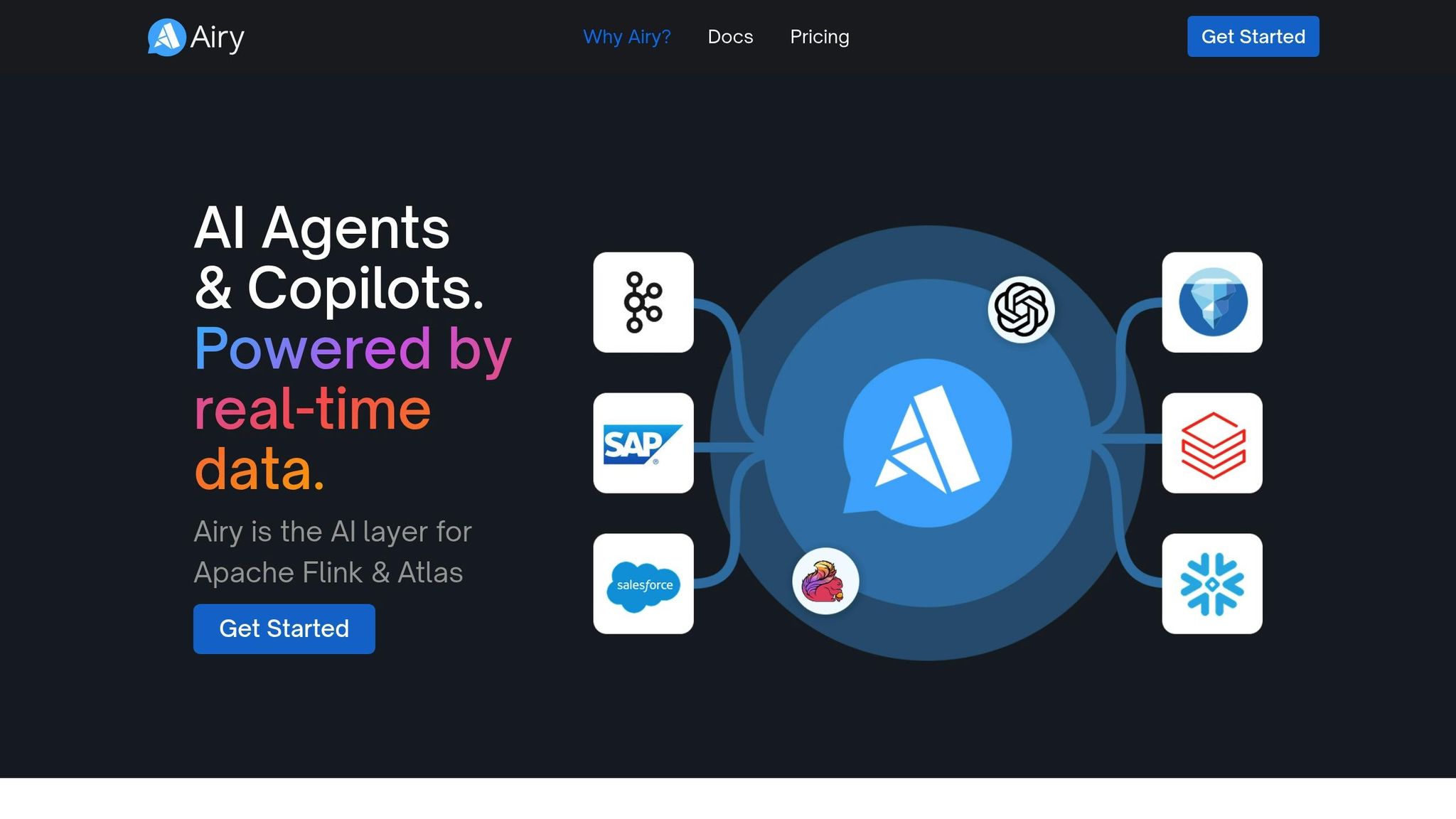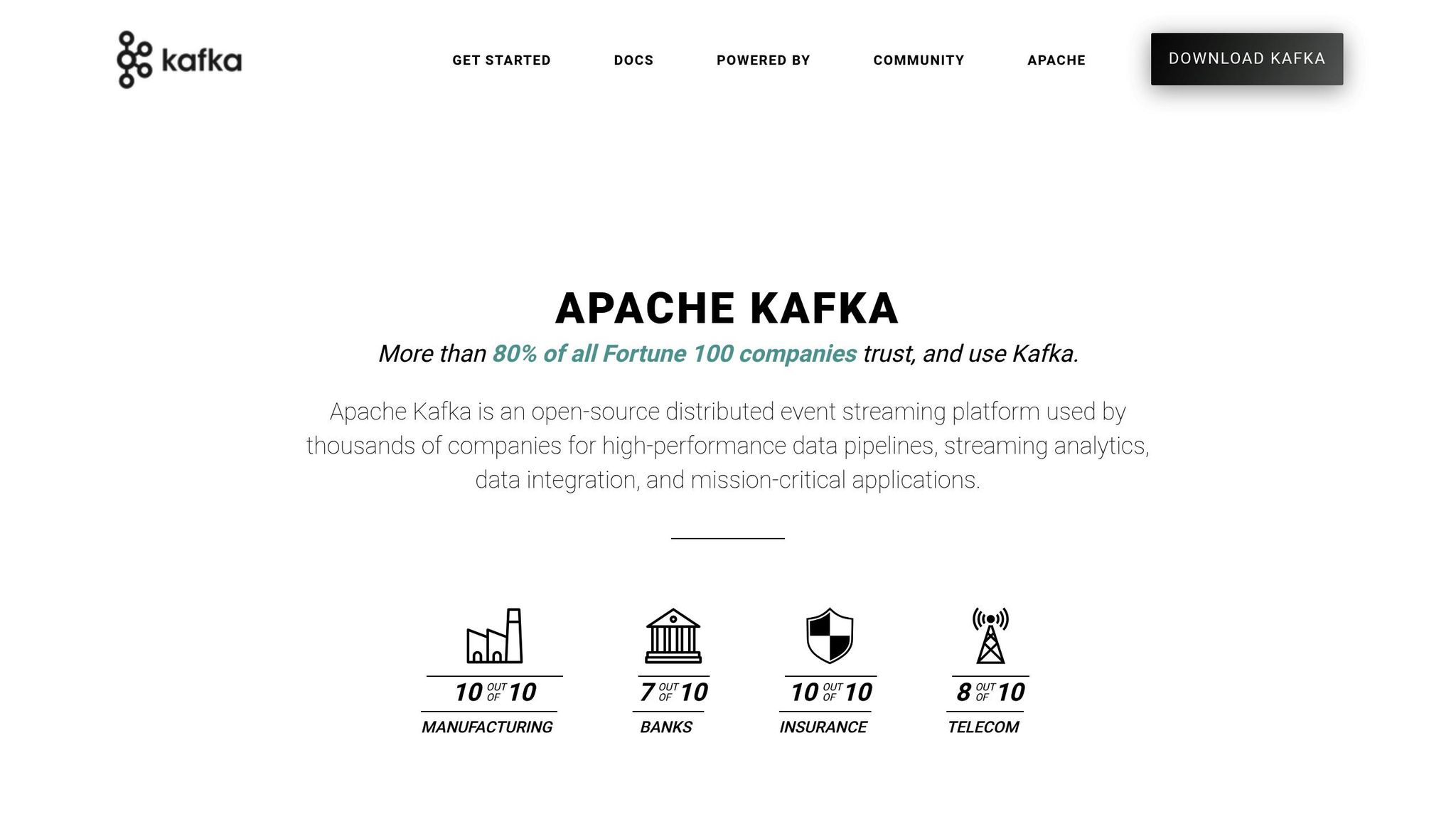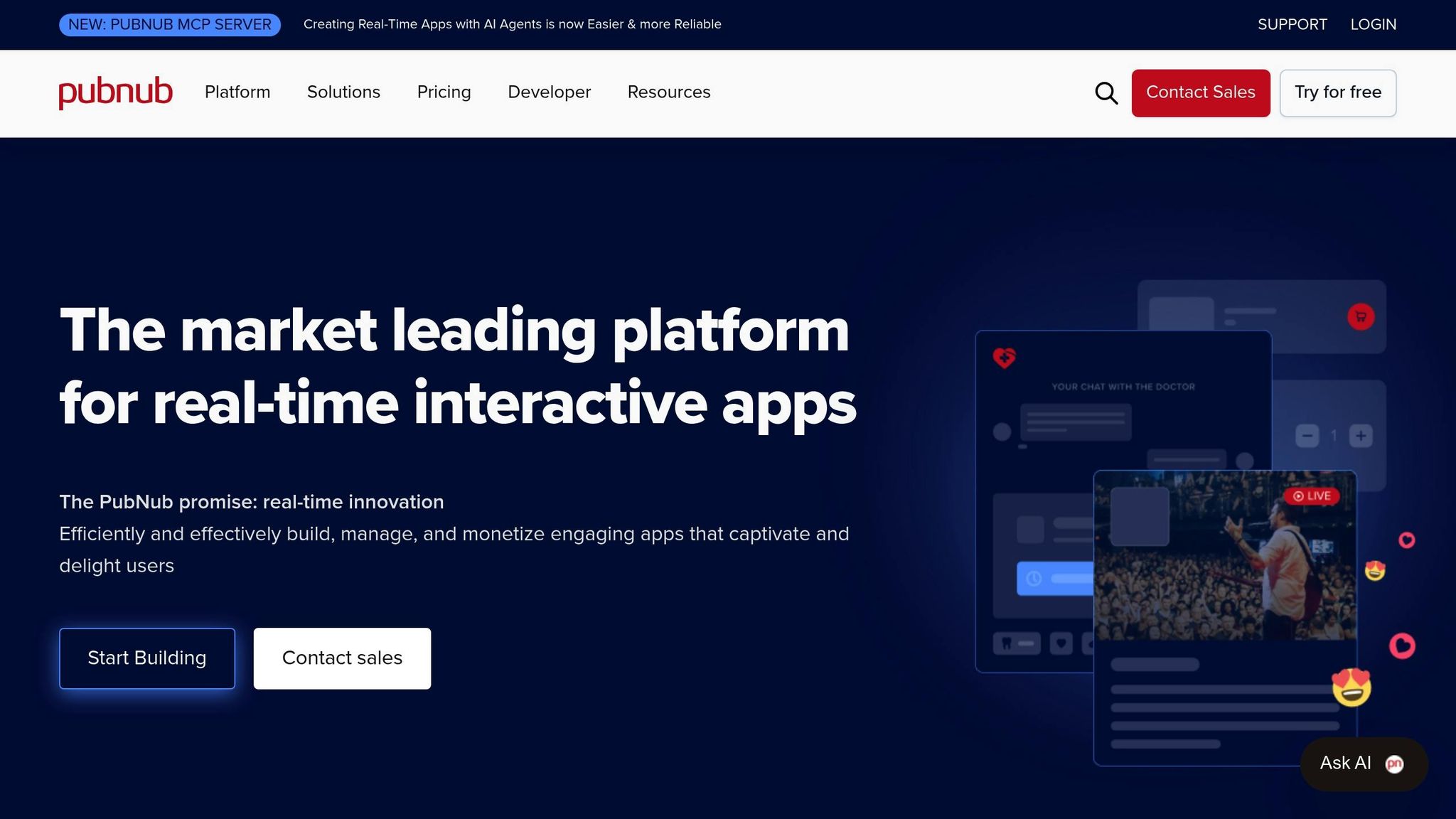Real-time data streaming is transforming how AI systems operate by delivering immediate access to information. Unlike batch processing, which works on delayed data, real-time streaming ensures AI applications can make decisions based on the latest inputs. This is crucial because relying on outdated data can lead to inefficiencies and missed opportunities.
Here are the key takeaways:
- Why it matters: 80% of companies still rely on outdated data, but those using real-time streaming report significant ROI and better decision-making.
- Benefits: Enables fraud detection, dynamic pricing, and predictive maintenance by processing information instantly.
- Leading platforms: AWS Kinesis, Apache Kafka, Confluent, and PubNub each offer unique capabilities for real-time AI applications.
- Future trends: By 2025, 90% of top companies are expected to adopt real-time streaming for AI-driven services.
Choosing the right platform depends on your needs. For example, AWS Kinesis integrates seamlessly with Amazon’s ecosystem, Apache Kafka offers flexibility for large-scale data handling, Confluent simplifies operations for enterprises, and PubNub excels in real-time communication.
Quick Comparison:
| Platform | Best For | Latency | Key Features |
|---|---|---|---|
| AWS Kinesis | AWS users, scalable AI workloads | ~200ms | Auto-scaling, strong AWS integrations |
| Apache Kafka | High data volume, customization | 2.5-30ms | Open-source, distributed architecture |
| Confluent | Enterprise-grade AI pipelines | Milliseconds | Managed services, 120+ pre-built connectors |
| PubNub | Real-time messaging, IoT | Sub-50ms | Global edge network, low-latency messaging |
Each platform suits different use cases, from fraud detection to IoT systems. The right choice depends on your technical needs, integrations, and budget.
How Airy Powers Real-Time AI Agents with Data Streaming and Confluent | Life Is But A Stream Podcast

1. AWS Kinesis

AWS Kinesis is Amazon's fully managed streaming platform, designed to handle massive real-time data volumes without the hassle of managing infrastructure. Its serverless design automatically adjusts to meet demand, allowing businesses to focus on building AI applications instead of worrying about scalability or maintenance.
Scalability
Kinesis is built to process data at impressive speeds, handling gigabytes per second with ease. It offers two scaling options to suit different needs:
- On-Demand Mode: Automatically adjusts to variable data loads, removing the need for capacity planning.
- Provisioned Mode: Lets businesses fine-tune capacity by managing the number of shards, offering more control over resources.
For those using Provisioned Mode, the Kinesis Shard Calculator can help determine the ideal number of shards based on data flow. This adaptability is crucial as the real-time data processing market continues to expand, with an expected annual growth rate of 21.5% from 2022 to 2028.
Integration Capabilities
Kinesis works seamlessly with over 40 AWS services and third-party tools, making it an excellent choice for AI applications that rely on diverse data sources. For instance:
- Kinesis Data Firehose: Delivers processed data directly to destinations like Amazon S3, Amazon Redshift, or Amazon OpenSearch Service.
- AWS Glue Integration: Simplifies data preparation for analytics and machine learning tasks.
Several organizations have used Kinesis to power AI-driven innovations. Crexi (Commercial Real Estate Exchange, Inc.) built a robust AI/ML pipeline framework with Kinesis. The National Hockey League (NHL) employs Kinesis for its Face-off Probability statistic, combining machine learning with real-time player and puck tracking data. Similarly, MEDHOST integrated Kinesis Data Streams into its analytics suite to predict cardiac risks.
Latency
In addition to its scalability and integration features, Kinesis ensures low-latency streaming, a critical factor for real-time AI. Data records are available for reading almost instantly after being written to a stream, with a typical delay of less than 1 second due to the default polling interval per shard. For even faster performance, Kinesis Data Streams can achieve end-to-end latency of around 200 milliseconds. While increasing polling frequency can reduce latency further, settings below 200 milliseconds may lead to throughput issues.
"The feature that I've found most valuable is the replay. That is one of the most valuable in our business. We are business-to-business so replay was an important feature - being able to replay for 24 hours. That's an important feature."
– reviewer1476249, Senior Software Engineer
Best Use Cases
Kinesis's capabilities make it a go-to solution for several AI-driven applications:
- Fraud Detection: Financial institutions analyze transaction patterns in real time to identify suspicious activity using models trained on historical data.
- Personalized Shopping: E-commerce platforms monitor user interactions to deliver tailored recommendations and targeted promotions instantly.
- Content Optimization: Streaming platforms like Netflix process viewer data in real time to refine content recommendations and boost engagement.
- Predictive Maintenance: Manufacturing companies collect sensor data from machinery and apply AI algorithms to predict and prevent equipment failures, reducing downtime and costs.
AWS Kinesis demonstrates how a scalable, integrated, and low-latency platform can empower AI applications that need real-time insights. Its serverless nature and flexibility make it a strong choice for businesses aiming to stay ahead in data-driven innovation.
2. Apache Kafka

Apache Kafka is an open-source distributed streaming platform that has become a cornerstone for many enterprise AI applications. Unlike managed services, Kafka offers organizations full control over their data streaming infrastructure, leveraging a distributed cluster to deliver high performance at scale.
Scalability
Kafka's distributed design is built to handle enormous volumes of data efficiently. It can process millions of messages per second, making it ideal for AI applications that rely on continuous data streams. With dynamic partitioning, Kafka allows multiple producers and consumers to work simultaneously, enabling horizontal scaling. For example, New Relic's Kafka cluster processes over 15 million messages every second. Kafka also simplifies cluster management by automatically balancing partitions when instances are added or removed. Its sticky partition assignment ensures stateful agents retain context during processing, which is crucial for maintaining efficiency.
Integration Capabilities
Kafka excels at connecting various data sources to AI platforms. It integrates smoothly with popular frameworks like TensorFlow and PyTorch, streamlining the flow of training data and model inputs. Kafka Connect acts as a bridge between Kafka and external systems, ensuring seamless data transfer. Tools like Kafka Streams and ksqlDB further enhance its capabilities by enabling real-time feature engineering and data preprocessing before feeding data into AI models. Kafka's architecture also supports integration with data lakes, machine learning pipelines, and cloud analytics platforms. This versatility has made it a go-to choice for major retailers implementing dynamic pricing and personalized recommendation systems. These integrations ensure Kafka not only manages data efficiently but also prepares it for low-latency AI processing.
Latency
Kafka delivers impressively low-latency performance. Benchmarks reveal end-to-end latencies ranging from 2.5 to 30 milliseconds while maintaining throughputs of 200,000 to 800,000 messages per second. By optimizing parameters such as linger.ms, batch.size, and acks, Kafka can achieve latencies as low as 2.5 milliseconds.
Best Use Cases
Kafka's architecture is perfectly suited for AI applications that require timely, data-driven decisions. It powers real-time fraud detection, predictive maintenance, and personalized recommendations by enabling continuous data ingestion. For fraud detection, Kafka allows financial institutions to process high-speed transaction data, enabling AI models to flag suspicious activities instantly. In predictive maintenance, Kafka monitors sensor data in real time, helping AI models forecast maintenance needs, which minimizes downtime and extends the lifespan of equipment. When it comes to recommendation systems, Kafka continuously processes consumer behavior data, feeding machine learning models with up-to-date insights for personalized suggestions. This is especially impactful, as studies show companies that excel in personalization see higher revenues, and 40% of consumers are willing to spend more when their experience feels tailored. These examples highlight the importance of real-time data streams in driving AI-powered decision-making.
With its ability to scale, integrate seamlessly, and deliver low latency, Apache Kafka is a powerful tool for organizations building AI applications that require real-time data processing and insights. Its reliable streaming capabilities provide a strong foundation for AI systems to make timely, informed decisions.
3. Confluent
Confluent builds on the capabilities of AWS Kinesis and Apache Kafka, offering a more refined, enterprise-ready solution for real-time data streaming. Developed by the original creators of Apache Kafka, Confluent simplifies real-time streaming with advanced features and managed services, making it accessible even to those without deep technical expertise in distributed systems.
Scalability
Confluent Cloud ensures high performance with a 99.99% uptime SLA, automatically scaling resources based on demand. By eliminating the need for manual cluster management, it reduces total ownership costs by up to 60% compared to self-managed setups. This efficiency is achieved through automated operations and optimized resource use, which eliminate the need for dedicated Kafka administration teams.
The platform’s integration with Apache Flink allows for large-scale stream processing, enabling real-time data transformation and enrichment. This combination provides a seamless solution for growing business needs, without requiring major architectural changes.
Integration Capabilities
Confluent offers a comprehensive suite of connectors designed for seamless integration with AI tools, databases, and cloud platforms. These connectors simplify workflows by storing endpoint and authentication details, streamlining connections to third-party services like APIs and AI/ML platforms.
Companies like Notion and Airy are leveraging these connectors to enhance their operations. Notion uses Confluent to process and share updates across databases in real time, ensuring consistent and reliable document views. This setup also accelerates the development of new applications based on retrieval-augmented generation (RAG).
Airy uses Confluent to power AI copilots that interact with data in natural language. Their Flink jobs act as agents monitoring data streams, while Flink AI Model Inference integrates directly with large language models (LLMs) and vector databases. This setup provides real-time context, enabling accurate Flink SQL queries for RAG-based applications.
"Confluent helps us accelerate copilot adoption for our customers, giving teams access to valuable real-time, organizational knowledge. Confluent's data streaming platform with Flink AI Model Inference simplified our tech stack by enabling us to work directly with large language models (LLMs) and vector databases for retrieval-augmented generation (RAG) and schema intelligence, providing real-time context for smarter AI agents." - Steffen Hoellinger, Co-founder and CEO at Airy
Similarly, Agent Taskflow uses Confluent’s platform to orchestrate real-time agent operations, allowing faster iteration and weekly feature releases. Reworkd AI also relies on Confluent to stream outputs from generative and agentic AI systems, enabling rapid development of new features in days rather than weeks.
Latency
Confluent’s low-latency streaming capabilities, validated by SAS Event Stream Processing, deliver insights in milliseconds. This speed is critical for AI applications where immediate response is essential - think fraud detection or dynamic pricing systems.
By ensuring near-instantaneous delivery of insights, Confluent allows AI and ML models to adapt to new data patterns and anomalies as they emerge. This continuous feedback loop is vital for maintaining the accuracy and relevance of AI systems.
Best Use Cases
Confluent is particularly effective for generative AI and agentic AI applications that require real-time data updates and context. Its integration with vector databases and LLMs makes it a strong choice for RAG-based applications demanding up-to-date, precise information.
For example, GEP Worldwide developed a real-time GenAI chatbot using Confluent to help enterprises optimize procurement and supply chain operations. The platform’s connectors retrieve the latest data, while stream processing shapes it into actionable insights. Stream Governance ensures the data remains reliable and compatible.
In another case, Uniper modernized its energy trading operations with Confluent and Databricks. Using Confluent Cloud alongside Apache Kafka and Apache Flink, Uniper created a scalable foundation for ingesting and processing market data, IoT sensor inputs, and operational events throughout the trading lifecycle.
"Building real-time AI applications has been too complex for too long, requiring a maze of tools and deep expertise just to get started. With the latest advancements in Confluent Cloud for Apache Flink, we're breaking down those barriers - bringing AI-powered streaming intelligence within reach of any team." - Shaun Clowes, Chief Product Officer at Confluent
Confluent’s unified event-driven streaming pipeline supports both operational and analytical workloads through a Kappa architecture model. This approach avoids the complexity of traditional Lambda architectures, making it especially useful for organizations that need to process both real-time and historical data within a single platform.
sbb-itb-bec6a7e
4. PubNub

PubNub is all about real-time communication and seamless connectivity across global networks. Unlike platforms that prioritize handling massive data sets, PubNub zeroes in on delivering instant messages worldwide. This approach makes it a go-to choice for AI applications that demand immediate interactions and responses. Let’s dive into its scalability, integrations, speed, and potential use cases.
Scalability
PubNub’s global edge network is designed to scale effortlessly. With a 99.999% uptime SLA, it ensures that critical AI applications remain available and reliable. By distributing processing across multiple edge locations worldwide, it minimizes single points of failure. This setup ensures dependable performance, even during high-traffic periods or regional disruptions.
Integration Capabilities
PubNub supports integration with thousands of AI models through its PubNub Functions. In 2023, it introduced the OpenAI Chat API, further simplifying real-time AI-driven communications. PubNub Functions allows developers to enrich data and connect with external models in real time. On top of that, PubNub Illuminate offers no-code tools for analytics, decision-making, and automation in real-time.
"Because PubNub's docs have always been publicly available (and well-indexed), virtually every major LLM (ChatGPT, Claude, etc.) 'speaks PubNub.'" – PubNub
Latency
One of PubNub’s standout features is its ultra-low latency. It achieves sub-50ms event propagation globally, with most messages delivered in under 100 milliseconds. For AI applications that rely on instant feedback, this speed ensures smooth and responsive interactions. For example, PubNub’s Auto-Moderation feature can scan messages for profanity, abuse, or spam in under 500ms.
"The world expects real-time, intelligent experiences. Our evolved platform brings AI, analytics, and moderation into the developer workflow, enabling safer, smarter apps with lower latency and greater impact." – Todd Greene, CEO, PubNub
Best Use Cases
PubNub shines in scenarios where real-time interaction and immediate feedback are essential. Here are some practical applications:
- Real-time chat apps with AI assistants: PubNub’s messaging platform integrates seamlessly with AI models, enabling dynamic, context-aware conversations.
- Live collaboration tools: Features like real-time language translation and intelligent content suggestions work efficiently on PubNub’s messaging backbone, enhancing shared experiences.
- IoT and sensor-driven AI systems: PubNub is ideal for managing streams of device data in smart buildings, industrial monitoring, or autonomous vehicles. It ensures AI systems receive real-time sensor data, enabling instant responses to changing conditions.
Additionally, PubNub Illuminate and PubNub Functions enable automation when anomalies are detected. For instance, if an AI model detects unusual patterns or opportunities in a data stream, the system can instantly send alerts, adjust user experiences, or allocate resources. This makes PubNub an excellent choice for AI applications that need to act on insights as they happen.
Platform Strengths and Weaknesses
Choosing the right real-time streaming platform depends on understanding the strengths and limitations of each option. Here's a breakdown to help you decide.
AWS Kinesis is a great fit for those heavily invested in the AWS ecosystem. It offers seamless integration with other AWS services and minimal operational overhead. However, its reliance on AWS infrastructure can lead to vendor lock-in, and costs can climb quickly for high-volume streaming.
Apache Kafka stands out as an open-source powerhouse, capable of handling massive data volumes with unmatched throughput. It gives users full control over configuration and deployment, making it a favorite for those who need flexibility. That said, managing Kafka can be complex, requiring skilled teams and robust infrastructure to operate efficiently.
Confluent builds on Kafka’s foundation, easing its operational challenges with enterprise-grade tools and a wide ecosystem. With over 120 pre-built connectors, it simplifies integration with various systems, including AI tools. As Confluent puts it:
"Using Confluent Data Streaming Platform, stream all your data in real time from everywhere, curate and govern them while in flight to deliver production-scale AI-powered applications faster".
However, these enterprise features come at a premium, with higher licensing costs compared to self-managed Kafka setups.
PubNub excels in delivering real-time performance with sub-50ms global latency and a reliable edge network boasting 99.999% uptime. It’s a strong choice for applications requiring instant interaction, such as IoT devices or live chat. On the flip side, it may not be ideal for processing extremely high data volumes.
When evaluating platforms, consider factors like connector availability, flexibility in schema design, deployment options, and monitoring tools. AI-driven platforms increasingly leverage machine learning to automate repetitive tasks and speed up workflows, while more traditional tools often require manual configurations. Understanding these differences can help you align the platform with your AI initiatives.
To summarize, here’s a quick comparison of each platform's scalability, integration, latency, and best use cases:
| Platform | Scalability | Integration Capabilities | Latency | Best Use Cases |
|---|---|---|---|---|
| AWS Kinesis | Auto-scaling within AWS ecosystem | Seamless with AWS services | Low for AWS workloads | AWS-centric AI, real-time analytics |
| Apache Kafka | Handles millions of events/second | Extensive, often requires custom development | Very low (with tuning) | High-volume data processing, event sourcing |
| Confluent | Enterprise-scale with managed services | 120+ pre-built connectors | Low with enterprise features | Multi-cloud AI, complex data pipelines |
| PubNub | Global edge network, 99.999% uptime | Strong API integrations | Sub-50ms globally | Real-time communication, IoT, instant feedback |
Your decision ultimately hinges on your specific needs. If you want quick deployment and managed services, AWS Kinesis or Confluent might be the way to go. For those prioritizing control and cost efficiency, Apache Kafka is a solid choice. And for real-time interaction with a global reach, PubNub delivers outstanding performance.
Conclusion
Real-time streaming is a cornerstone of AI success, with data-driven companies being 23 times more likely to acquire customers and 19 times more likely to achieve profitability. When it comes to choosing between platforms like AWS Kinesis, Apache Kafka, Confluent, and PubNub, the decision ultimately hinges on your specific AI needs and organizational constraints.
For applications requiring high-throughput predictive analytics, Apache Kafka stands out. Its ability to handle massive data volumes with minimal latency makes it perfect for training machine learning models on continuous data streams. However, leveraging Kafka effectively often requires a team with strong engineering expertise. On the other hand, platforms optimized for low latency are essential for time-sensitive tasks like fraud detection and personalization.
If your organization operates within a cloud ecosystem, integration becomes a critical factor. AWS Kinesis pairs seamlessly with other AWS AI services, while Confluent Cloud offers tools to simplify multi-cloud deployments, making it a strong choice for complex, distributed environments.
Cost is another significant consideration. For smaller AI automation projects, budgets typically fall between $10,000 and $50,000, while enterprise-grade solutions can surpass $1 million. Additionally, AI talent costs range from $100,000 to $300,000 annually, which can significantly impact your overall investment.
To make the right choice, start by identifying high-impact use cases that require real-time insights. Assess your current data architecture to determine where streaming can replace batch processes. As Carlie Idoine from Gartner notes:
"You don't have to be an expert to go in and use these tools anymore".
Selecting the right platform from the beginning can save you from costly migrations down the road.
Looking ahead, the ability to act on data in real time will separate leaders from laggards. By 2025, it’s predicted that successful data-driven enterprises will automate up to 50% of decisions using real-time analytics. Your choice of streaming platform today will define whether your AI applications thrive in this fast-paced future or lag behind with outdated insights.
For businesses seeking AI tools to complement their streaming infrastructure, platforms like AI for Businesses provide curated solutions such as Stability.ai and Writesonic, tailored to help SMEs and scale-ups enhance their operations alongside robust data streaming capabilities.
Make your streaming platform choice wisely - it’s the foundation for leading in real-time decision-making.
FAQs
What should I consider when selecting a real-time data streaming platform for my AI application?
When selecting a real-time data streaming platform for your AI application, it's essential to focus on a few key aspects: low latency, high throughput, and scalability. These features ensure your system can process large amounts of data quickly and efficiently. Look for platforms that easily integrate with your existing tools and can handle unstructured data, as these are often critical for AI-driven workflows.
Equally important are platforms with robust data governance capabilities. Strong governance ensures data quality, security, and compliance, which are vital for delivering accurate, timely information to your AI models. By prioritizing these factors, you can ensure your AI system generates reliable insights and supports real-time decision-making effectively.
How do AWS Kinesis, Apache Kafka, Confluent, and PubNub differ in terms of integration and scalability?
AWS Kinesis is built to handle fluctuating data volumes effortlessly, automatically scaling to match the demands of dynamic workloads. In contrast, Apache Kafka provides powerful scalability through its broker and partition management. However, managing Kafka requires more manual configuration and ongoing maintenance.
Confluent, which is based on Kafka, streamlines scalability and management by offering enterprise-grade features, though this convenience comes with a higher price tag. Meanwhile, PubNub shines in delivering real-time data to end-user devices, making it a strong choice for distributed environments where low-latency communication is a priority. Each platform offers distinct advantages, so the right pick will depend on your specific needs and goals.
How does real-time data streaming boost AI performance and decision-making?
Real-time data streaming transforms AI systems by providing instant access to the latest information, which leads to quicker and more precise decision-making. This constant flow of current data empowers businesses to react swiftly to changes, boosting efficiency and cutting down on delays.
With a steady stream of reliable, up-to-date data, this technology supports essential applications like predictive maintenance and real-time analytics. These tools are particularly crucial in industries where timing and accuracy are non-negotiable, helping organizations stay ahead of the curve and maintain a competitive edge.


